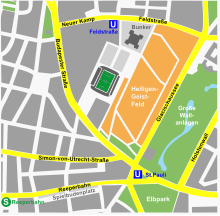
Hamburg, officially the Free and Hanseatic City of Hamburg, is the second-largest city in Germany after Berlin and 6th-largest in the European Union with a population of over 1.9 million. The Hamburg Metropolitan Region has a population of over 5.1 million and is the eighth-biggest metropolitan region by GDP in the European Union.

The Rote Flora is a former theatre in the Sternschanze district of Hamburg, Germany. It has been squatted since November 1989 as a self-managed social centre. The collective said in 2001 "We are the 'UFO in the neighbourhood.' The black hole in public space. The City won't get rid of us because we are a part of what life is."
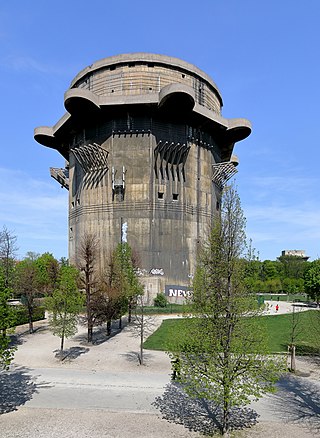
Flak towers were large, above-ground, anti-aircraft gun blockhouse towers constructed by Nazi Germany. There were a total of 8 flak tower complexes in the cities of Berlin (three), Hamburg (two), and Vienna (three) from 1940 onwards. Other cities that used flak towers included Stuttgart and Frankfurt. Smaller single-purpose flak towers were built at key outlying German strongpoints, such as at Angers in France, and Heligoland in Germany.

St. Anne's Museum Quarter was previously an Augustinian nunnery, St. Anne's Priory. Since 1915 it has housed St. Anne's Museum, one of Lübeck's museums of art and cultural history containing Germany's largest collection of medieval sculpture and altar-pieces, including the famous altars by Hans Memling, Bernt Notke, Hermen Rode, Jacob van Utrecht and Benedikt Dreyer.
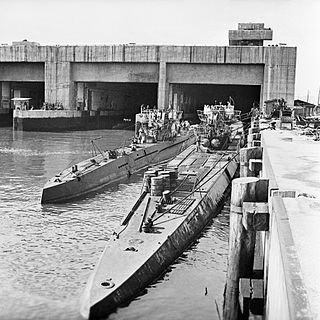
A submarine pen is a type of submarine base that acts as a bunker to protect submarines from air attack.

Millerntor-Stadion is a multi-purpose stadium in the St. Pauli area of Hamburg, Germany. Best known as the home ground of football club FC St. Pauli, it is on the Heiligengeistfeld near the Reeperbahn, the red light district of Hamburg. The stadium had a capacity of 32,000 when it was built in 1961. It is also used by the Blue Devils American football team, and as a concert venue, including a performance by Prince in 1988. FC St. Pauli celebrated their centenary festival at the stadium in 2010.

Hamburger Bahnhof is the former terminus of the Berlin–Hamburg Railway in Berlin, Germany, on Invalidenstrasse in the Moabit district opposite the Charité hospital. Today it serves as a contemporary art museum, the Museum für Gegenwart, part of the Berlin National Gallery.
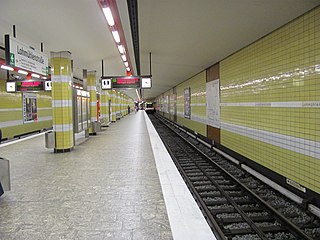
Lohmühlenstraße is a public transport metro station for the rapid transit trains on the line U1 located in Hamburg, Germany in the quarter St. Georg in the Hamburg-Mitte borough.

The Internationales Maritimes Museum Hamburg is a private museum in the HafenCity quarter of Hamburg, Germany. The museum houses Peter Tamm's collection of model ships, construction plans, uniforms, and maritime art, amounting to over 40,000 items and more than one million photographs. It opened in a former warehouse in 2008.

The Hamburger Dom is a large fair held at the Heiligengeistfeld fair ground in central Hamburg, Germany. With three fairs per year it is the biggest and the longest fair throughout Germany and attracts approximately ten million visitors per year. It is also referred to as a Volksfest. The Hamburger Dom is also one of the well known festivals in the Hamburg metropolitan area.
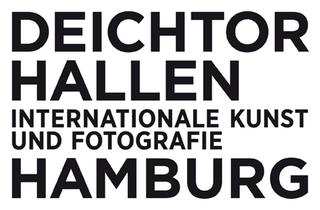
The Deichtorhallen in Hamburg, Germany, is one of Europe's largest art centers for contemporary art and photography. The two historical buildings dating from 1911 to 1913 are iconic in style, with their open steel-and-glass structures. Their architecture creates a backdrop for spectacular major international exhibitions.

Saint Mary's Cathedral in Hamburg was the cathedral of the ancient Roman Catholic Archdiocese of Hamburg, which was merged in personal union with the Diocese of Bremen in 847, and later in real union to form the Archdiocese of Hamburg-Bremen, as of 1027.

The Oper am Gänsemarkt was a theatre in Hamburg, Germany, built in 1678 after plans of Girolamo Sartorio at the Gänsemarkt square. It was the first public opera house to be established in Germany: not a court opera, as in many other towns. Everybody could buy a ticket, like in Venice. Most works were in the German language or translated librettos.

St. Pauli station is a metro station located in St. Pauli, Hamburg, Germany close to the Reeperbahn. The station was opened in 1912 is served by the Hamburg U-Bahn line U3. St.Pauli station is often used by passengers travelling to the Hamburger Dom fair at Heiligengeistfeld, as it is located closely to its southern entrance.

Feldstraße station is a metro station located in St. Pauli, Hamburg, Germany. It is served by Hamburg U-Bahn line U3 ; the station handles an average of around 14,000 passengers per day.

The great fire of Hamburg began early on May 5, 1842, in Deichstraße and burned until the morning of May 8, destroying about one third of the buildings in the Altstadt. It killed 51 people and destroyed 1,700 residences and several important public buildings, necessitating major civic rebuilding and prompting infrastructure improvements. The heavy demand on insurance companies led to the establishment of reinsurance.

Kiwittsmoor is a station on the Hamburg U-Bahn line U1. It was opened in May 1960 and is located in Hamburg, Germany, in the quarter of Langenhorn. Langenhorn is part of the borough of Hamburg-Nord.

Stephansplatz is a square in Neustadt quarter, Hamburg, Germany. It is located at the junction of the streets of Dammtordamm, Esplanade, Dammtorstraße, and Gorch-Fock-Wall, south of Dammtor area and Dammtor station. The square is named after German Empire post director Heinrich von Stephan, who is known for his role in the founding of the Universal Postal Union. The square and a small part of the streets of Dammtordamm and Dammtorstraße had been renamed in the course of the inauguration of the historical building of Alte Oberpostdirektion at the square.

Spitalerstraße is a shopping street in the Altstadt quarter, Hamburg, Germany. The street, a pedestrian zone, is one of the central shopping districts of the city and forms a diagonal junction from Gerhart-Hauptmann-Platz/Mönckebergstraße boulevard in the west to Hamburg Hauptbahnhof/Steintorwall in the east. It is the most frequented street by pedestrians in Hamburg - ahead nearby Mönckebergstraße - and the fifth most frequented street in Germany with 13,070 persons per hour on a Saturday by 2015.

The Dancing Towers are two highrises at the eastern end of Reeperbahn, in St. Pauli, Hamburg, Germany. Designed by BRT Architects of Hadi Teherani and funded by Strabag, they were completed in 2012. Inside the buildings, office space, gastronomy, a radio station, as well as music club and live venue the Mojo Club can be found. The Mojo Club had been located here before, in the pile of a former bowling alley which was standing empty for years, then being demolished.
